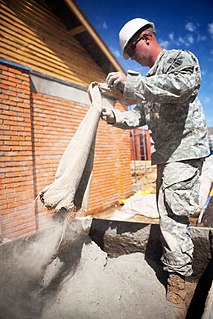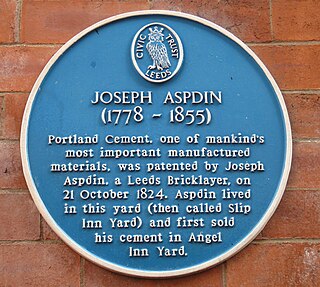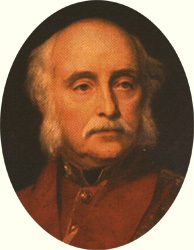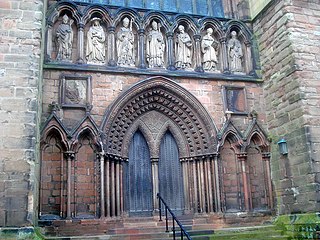Related Research Articles

A cement is a binder, a substance used for construction that sets, hardens, and adheres to other materials to bind them together. Cement is seldom used on its own, but rather to bind sand and gravel (aggregate) together. Cement mixed with fine aggregate produces mortar for masonry, or with sand and gravel, produces concrete. Concrete is the most widely used material in existence and is only behind water as the planet's most-consumed resource.

Portland cement is the most common type of cement in general use around the world as a basic ingredient of concrete, mortar, stucco, and non-specialty grout. It was developed from other types of hydraulic lime in England in the early 19th century by Joseph Aspdin, and usually originates from limestone. It is a fine powder, produced by heating limestone and clay minerals in a kiln to form clinker, grinding the clinker, and adding 2 to 3 percent of gypsum. Several types of Portland cement are available. The most common, called ordinary Portland cement (OPC), is grey, but white Portland cement is also available. Its name is derived from its similarity to Portland stone which was quarried on the Isle of Portland in Dorset, England. It was named by Joseph Aspdin who obtained a patent for it in 1824. However, his son William Aspdin is regarded as the inventor of "modern" Portland cement due to his developments in the 1840s.
The year 1824 in science and technology involved some significant events, listed below.

Mortar is a workable paste which dries to bind building blocks such as stones, bricks, and concrete masonry units, to fill and seal the irregular gaps between them, and sometimes to add decorative colors or patterns to masonry walls. In its broadest sense, mortar includes pitch, asphalt, and soft mud or clay, as used between mud bricks. The word "mortar" comes from Latin mortarium, meaning crushed.

James Henry Greathead was a mechanical and civil engineer renowned for his work on the London Underground railways, Winchester Cathedral and, Liverpool overhead railway as well as being one of the earliest proponents of the English Channel, Irish Sea and Bristol Channel tunnels. His invention is also the reason that the London Underground is colloquially named the "Tube".

Joseph Aspdin was an English cement manufacturer who obtained the patent for Portland cement on 21 October 1824.

Swanscombe (/ˈswɒnzkəm/) is a town in the Borough of Dartford in Kent, England and the civil parish of Swanscombe and Greenhithe. It is located 4.4 miles west of Gravesend and 4.8 miles east of Dartford.

Northfleet is a town in the borough of Gravesham in Kent, England. It is located immediately west of Gravesend, and on the border with the Borough of Dartford. Northfleet has its own railway station on the North Kent Line, just east of Ebbsfleet International railway station on the High Speed 1 line.

General Sir Charles William Pasley was a British soldier and military engineer who wrote the defining text on the role of the post-American revolution British Empire: An Essay on the Military Policy and Institutions of the British Empire, published in 1810. This text changed how Britons thought their empire should relate to the rest of the world. He warned that Britain could not keep its Empire by its "splendid isolation". Britain would need to fight to gain its empire, and by using the colonies as a resource for soldiers and sailors it grew by an average of 100,000 square miles (260,000 km2) per year between the Battle of Waterloo and the American Civil War. Serving in the Royal Engineers in the Napoleonic Wars, he was Europe's leading demolitions expert and siege warfare specialist.

Plasterwork is construction or ornamentation done with plaster, such as a layer of plaster on an interior or exterior wall structure, or plaster decorative moldings on ceilings or walls. This is also sometimes called pargeting. The process of creating plasterwork, called plastering or rendering, has been used in building construction for centuries. For the art history of three-dimensional plaster, see stucco.

South Ferriby is a village in North Lincolnshire, England. It is situated on the south bank of the Humber Estuary and 3 miles (5 km) west from the Humber Bridge. North Ferriby is directly opposite on the Estuary’s north bank. Village population was 651 in 2011.
Isaac Charles Johnson was a British cement manufacturer, and a pioneer of the Portland cement industry.

William Aspdin was an English cement manufacturer, and a pioneer of the Portland cement industry. He is considered the inventor of "modern" Portland cement. He has also been termed "an incorrigible liar and swindler".

Blue Circle Industries was a British public company manufacturing cement. It was founded in 1900 as the Associated Portland Cement Manufacturers Ltd through the fusion of 24 cement works, mostly located on the Thames and Medway estuaries, together having around a 70% market share of the British cement market. In 1911, the British Portland Cement Manufacturers Ltd. was formed by the addition of a further 35 companies, creating a company with an initial 80% of the British cement market.
The Leeds Forge Company manufactured corrugated furnaces for marine steam engine boilers and later, pressed steel railway vehicles, in Leeds, England.

A raw mill is the equipment used to grind raw materials into "rawmix" during the manufacture of cement. Rawmix is then fed to a cement kiln, which transforms it into clinker, which is then ground to make cement in the cement mill. The raw milling stage of the process effectively defines the chemistry of the finished cement, and has a large effect upon the efficiency of the whole manufacturing process.
James Frost (1780?-1840?) was a British cement manufacturer who invented processes that led to the eventual development of Portland cement.

Roman cement is a substance developed by James Parker in the 1780s, being patented in 1796.
Charles Richardson was the founder of the family Brick and Cement Firm A & WT Richardson Ltd, which lasted over 100 years. On 18 October 1840 he married Selina Ellis at Lambeth. The couple had one daughter, Selina Richardson born March 1842 and four sons - Alexander R Richardson born 1847, Walter T Richardson born 1849, Frederick Charles Richardson born 1851 and George Canning Richardson born March 1855.

The Edison Ore-Milling Company was a venture by Thomas Edison that began in 1881. Edison introduced some significant technological developments to the iron ore milling industry but the company ultimately proved to be unprofitable. Towards the end of the company's life, Edison realized the potential application of his technologies to the cement industry and formed the Edison Portland Cement Company in 1899.
References
- Thurston A P, Parker's "Roman" Cement, Transactions of the Newcomen Society 1939 P193-206 (Newcomen Society)
- Major A J Francis, The Cement Industry 1796-1914 A History, 1977, Davis & Charles (Publishers) Ltd, Devon UK, North Pomfret Vermont US, North Vancouver Canada